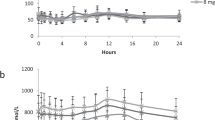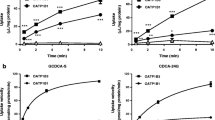Abstract
Background
Valproic acid (VPA) is a widely used anticonvulsant drug which affects mitochondrial metabolism including the catabolism of fatty acids and branched-chain amino acids.
Aims
To elucidate the effect of valproate on the leucine pathway through a targeted metabolomics approach and the evaluation of the effects of valproate on the activity of biotinidase and 3-methylcrotonyl-CoA carboxylase (3MCC).
Methods
Urine organic acid analysis was performed in patients under VPA therapy and healthy controls using gas-chromatography/mass spectrometry (GC-MS). Biotinidase activity was determined in plasma samples of both groups using an optimized spectrophotometric assay. After immunoprecipitation of short-chain enoyl-CoA hydratase (crotonase, ECHS1), 3MCC activity was measured in human liver homogenate using high-performance liquid chromatography (HPLC), in the absence and presence of valproyl-CoA.
Results
The levels of 3-hydroxyisovaleric acid (3OH-IVA), one secondary metabolite of the leucine pathway, were significantly elevated in human urine after VPA treatment. Biotinidase activity in plasma samples ranged from very low to normal levels in treated patients as compared with controls. Enzyme activity measurements revealed inhibition of 3-methylcrotonyl-CoA carboxylase by valproyl-CoA (IC50 = 1.36 mM). Furthermore, we show that after complete immunoprecipitation of crotonase in a human liver homogenate, 3-hydroxyisovaleryl-CoA is not formed.
Discussion
Our results suggest the interference of VPA with the activity of 3MCC through a potential cumulative effect: direct inhibition of the enzyme activity by the drug metabolite valproyl-CoA and the inhibition of biotinidase by valproate and/or its metabolites. These interactions may be associated with the skin rash and hair loss which are side effects often reported in VPA-treated patients.




Similar content being viewed by others
Abbreviations
- VPA:
-
2-n-propylpentanoic acid or valproic acid
- CoA:
-
Coenzyme A
- VP-CoA:
-
Valproyl-CoA
- 3OH-IVA:
-
3-hydroxyisovaleric acid
- 3MCC:
-
3-Methylcrotonyl-CoA carboxylase (EC 6.4.1.4)
- ECHS1:
-
Short-chain enoyl-CoA hydratase or crotonase (EC 4.2.1.17)
- BTD:
-
Biotinidase (EC 3.5.1.12)
References
Arslan M, Vurucu S, Balamtekin N, Unay B, Akin R, Kurt I, Ozcan O (2009) The effects of biotin supplementation on serum and liver tissue biotinidase enzyme activity and alopecia in rats which were administrated to valproic acid. Brain Dev 31:405–410
Bartlett K, Ghneim HK, Stirk JH, Wastell HJ, Sherratt HS, Leonard JV (1985) Enzyme studies in combined carboxylase deficiency. Ann NY Acad Sci 447:235–251
Baumgartner MR (2005) Molecular mechanism of dominant expression in 3-methylcrotonyl-CoA carboxylase deficiency. J Inherit Metab Dis 28:301–309
Baumgartner ER, Suormala T (1997) Multiple carboxylase deficiency: inherited and acquired disorders of biotin metabolism. Int J Vitam Nutr Res 67:377–384
Castro-Gago M, Gómez-Lado C, Eirís-Puñal J, Diaz-Mayo I, Castiñeiras-Ramos DE (2010) Serum biotinidase activity in children treated with valproic acid and carbamazepine. J Child Neurol 25:32–35
Hymes J, Fleischhauer K, Wolf B (1997) Biotinidase in serum and tissues. Methods Enzymol 279:422–434
Korkmazer N, Vurucu S, Demirkaya E, Unay B, Kul M, Akin R, Gokcay E (2006) Serum and liver tissue biotinidase enzyme activity in rats which were administrated to valproic acid. Brain Dev 28:515–520
Luis PB, Ruiter JP, IJlst L, Tavares de Almeida I, Duran M, Mohsen AW, Vockley J, Wanders RJ, Silva MF (2011a) Role of isovaleryl-CoA dehydrogenase and short branched-chain acyl-CoA dehydrogenase in the metabolism of valproic acid: implications for the branched-chain amino acid oxidation pathway. Drug Metab Dispos 39:1155–1160
Luis PB, Ruiter JP, Ofman R, IJlst L, Moedas M, Diogo L, Garcia P, de Almeida IT, Duran M, Wanders RJ, Silva MF (2011b) Valproic acid utilizes the isoleucine breakdown pathway for its complete β-oxidation. Biochem Pharmacol 82:1740–1746
McKinney PA, Finkenbine RD, DeVane CL (1996) Alopecia and mood stabilizer therapy. Ann Clin Psychiatry 8:183–185
Mock DM, Dyken ME (1997) Biotin catabolism is accelerated in adults receiving long-term therapy with anticonvulsants. Neurology 49:1444–1447
Mock NI, Mock DM (1992) Biotin deficiency in rats: disturbances of leucine metabolism are detectable early. J Nutr 122:1493–1499
Mock NI, Malik MI, Stumbo PJ, Bishop WP, Mock DM (1997) Increased urinary excretion of 3-hydroxyisovaleric acid and decreased urinary excretion of biotin are sensitive early indicators of decreased biotin status in experimental biotin deficiency. Am J Clin Nutr 65:951–958
Mock DM, Stratton SL, Horvath TD, Bogusiewicz A, Matthews NI, Henrich CL, Dawson AM, Spencer HJ, Owen SN, Boysen G, Moran JH (2011) Urinary excretion of 3-hydroxyisovaleric acid and 3-hydroxyisovaleryl carnitine increases in response to a leucine challenge in marginally biotin-deficient humans. J Nutr 141:1925–1930
Pabuccuoglu A, Aydogdu S, Bas M (2002) Serum biotinidase activity in children with chronic liver disease and its clinical significance. J Pediatr Gastroenterol Nutr 34:59–62
Pasquali M, Monsen G, Richardson L, Alston M, Longo N (2006) Biochemical findings in common inborn errors of metabolism. Am J Med Genet C Semin Med Genet 142C:64–76
Pindolia K, Jordan M, Guo C, Matthews N, Mock DM, Strovel E, Blitzer M, Wolf B (2011) Development and characterization of a mouse with profound biotinidase deficiency: a biotin-responsive neurocutaneous disorder. Mol Genet Metab 102:161–169
Sanders RJ, Ofman R, Dacremont G, Wanders RJ, Kemp S (2008) Characterization of the human omega-oxidation pathway for omega-hydroxy-very-long-chain fatty acids. FASEB J 22:2064–2071
Schulpis KH, Karikas GA, Tjamouranis J, Regoutas S, Tsakiris S (2001) Low serum biotinidase activity in children with valproic acid monotherapy. Epilepsia 42:1359–1362
Silva MF, Ruiter JP, Ijlst L, Allers P, ten Brink HJ, Jakobs C, Duran M, Tavares de Almeida I, Wanders RJ (2001a) Synthesis and intramitochondrial levels of valproyl-coenzyme A metabolites. Anal Biochem 290:60–67
Silva MF, Selhorst J, Overmars H, van Gennip AH, Maya M, Wanders RJ, Tavares de Almeida I, Duran M (2001b) Characterization of plasma acylcarnitines in patients under valproate monotherapy using ESI-MS/MS. Clin Biochem 34:635–638
Silva MF, Aires CC, Luis PB, Ruiter JP, Ijlst L, Duran M, Wanders RJ, Tavares de Almeida I (2008) Valproic acid metabolism and its effects on mitochondrial fatty acid oxidation: a review. J Inherit Metab Dis 31:205–216
Suormala T, Baumgartner M, Fowler B (2008) Biotinidase. In: Blau N, Duran M, Gibson KM (eds) Laboratory Guide to the Methods in Biochemical Genetics. Springer-Verlag, Berlin Heidelberg, 253–264
Sweetman L, Nyhan WL, Sakati NA, Ohlsson A, Mange MS, Boychuk RB, Kaye R (1982) Organic aciduria in neonatal multiple carboxylase deficiency. J Inherit Metab Dis 5:49–53
Tanaka K, Orr JC, Isselbacher KJ (1968) Identification of beta-hydroxyisovaleric acid in the urine of a patient with isovaleric acidemia. Biochim Biophys Acta 152:638–641
Vockley J, Ensenauer R (2006) Isovaleric acidemia: new aspects of genetic and phenotypic heterogeneity. Am J Med Genet C Semin Med Genet 142C:95–103
Wallace SJ (1996) A comparative review of the adverse effects of anticonvulsants in children with epilepsy. Drug Saf 15:378–393
Wolf B, Grier RE, Allen RJ, Goodman SI, Kien CL (1983) Biotinidase deficiency: the enzymatic defect in late-onset multiple carboxylase deficiency. Clin Chim Acta 131:273–281
Yilmaz Y, Tasdemir HA, Paksu MS (2009) The influence of valproic acid treatment on hair and serum zinc levels and serum biotinidase activity. Eur J Paediatr Neurol 13:439–443
Acknowledgements
This work was financially supported by Fundação para a Ciência e a Tecnologia (FCT), Lisboa, Portugal (SFRH/BD/25913/2005).
Author information
Authors and Affiliations
Corresponding author
Additional information
Communicated by: K. Michael Gibson
Ronald J. Wanders and Margarida F. B. Silva are equal last authors
Rights and permissions
About this article
Cite this article
Luís, P.B.M., Ruiter, J.P., IJlst, L. et al. Inhibition of 3-methylcrotonyl-CoA carboxylase explains the increased excretion of 3-hydroxyisovaleric acid in valproate-treated patients. J Inherit Metab Dis 35, 443–449 (2012). https://doi.org/10.1007/s10545-011-9423-4
Received:
Revised:
Accepted:
Published:
Issue Date:
DOI: https://doi.org/10.1007/s10545-011-9423-4




